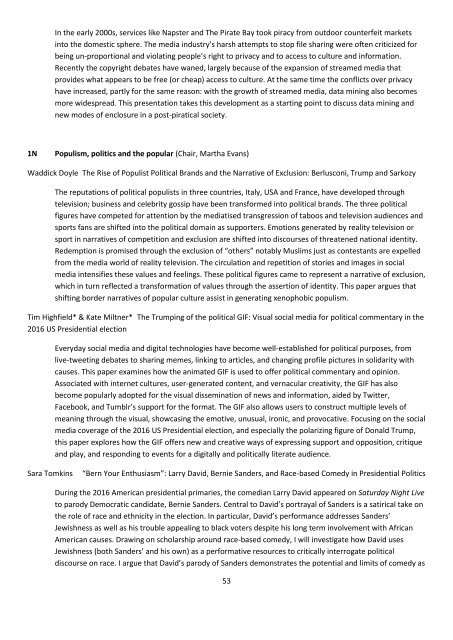Crossroads in Cultural Studies Conference 14-17th December 2016 Program Index
Crossroads-2016-final-draft-program-30-Nov
Crossroads-2016-final-draft-program-30-Nov
Create successful ePaper yourself
Turn your PDF publications into a flip-book with our unique Google optimized e-Paper software.
In the early 2000s, services like Napster and The Pirate Bay took piracy from outdoor counterfeit markets<br />
<strong>in</strong>to the domestic sphere. The media <strong>in</strong>dustry’s harsh attempts to stop file shar<strong>in</strong>g were often criticized for<br />
be<strong>in</strong>g un-proportional and violat<strong>in</strong>g people’s right to privacy and to access to culture and <strong>in</strong>formation.<br />
Recently the copyright debates have waned, largely because of the expansion of streamed media that<br />
provides what appears to be free (or cheap) access to culture. At the same time the conflicts over privacy<br />
have <strong>in</strong>creased, partly for the same reason: with the growth of streamed media, data m<strong>in</strong><strong>in</strong>g also becomes<br />
more widespread. This presentation takes this development as a start<strong>in</strong>g po<strong>in</strong>t to discuss data m<strong>in</strong><strong>in</strong>g and<br />
new modes of enclosure <strong>in</strong> a post-piratical society.<br />
1N<br />
Populism, politics and the popular (Chair, Martha Evans)<br />
Waddick Doyle The Rise of Populist Political Brands and the Narrative of Exclusion: Berlusconi, Trump and Sarkozy<br />
The reputations of political populists <strong>in</strong> three countries, Italy, USA and France, have developed through<br />
television; bus<strong>in</strong>ess and celebrity gossip have been transformed <strong>in</strong>to political brands. The three political<br />
figures have competed for attention by the mediatised transgression of taboos and television audiences and<br />
sports fans are shifted <strong>in</strong>to the political doma<strong>in</strong> as supporters. Emotions generated by reality television or<br />
sport <strong>in</strong> narratives of competition and exclusion are shifted <strong>in</strong>to discourses of threatened national identity.<br />
Redemption is promised through the exclusion of “others” notably Muslims just as contestants are expelled<br />
from the media world of reality television. The circulation and repetition of stories and images <strong>in</strong> social<br />
media <strong>in</strong>tensifies these values and feel<strong>in</strong>gs. These political figures came to represent a narrative of exclusion,<br />
which <strong>in</strong> turn reflected a transformation of values through the assertion of identity. This paper argues that<br />
shift<strong>in</strong>g border narratives of popular culture assist <strong>in</strong> generat<strong>in</strong>g xenophobic populism.<br />
Tim Highfield* & Kate Miltner* The Trump<strong>in</strong>g of the political GIF: Visual social media for political commentary <strong>in</strong> the<br />
<strong>2016</strong> US Presidential election<br />
Everyday social media and digital technologies have become well-established for political purposes, from<br />
live-tweet<strong>in</strong>g debates to shar<strong>in</strong>g memes, l<strong>in</strong>k<strong>in</strong>g to articles, and chang<strong>in</strong>g profile pictures <strong>in</strong> solidarity with<br />
causes. This paper exam<strong>in</strong>es how the animated GIF is used to offer political commentary and op<strong>in</strong>ion.<br />
Associated with <strong>in</strong>ternet cultures, user-generated content, and vernacular creativity, the GIF has also<br />
become popularly adopted for the visual dissem<strong>in</strong>ation of news and <strong>in</strong>formation, aided by Twitter,<br />
Facebook, and Tumblr’s support for the format. The GIF also allows users to construct multiple levels of<br />
mean<strong>in</strong>g through the visual, showcas<strong>in</strong>g the emotive, unusual, ironic, and provocative. Focus<strong>in</strong>g on the social<br />
media coverage of the <strong>2016</strong> US Presidential election, and especially the polariz<strong>in</strong>g figure of Donald Trump,<br />
this paper explores how the GIF offers new and creative ways of express<strong>in</strong>g support and opposition, critique<br />
and play, and respond<strong>in</strong>g to events for a digitally and politically literate audience.<br />
Sara Tomk<strong>in</strong>s<br />
“Bern Your Enthusiasm”: Larry David, Bernie Sanders, and Race-based Comedy <strong>in</strong> Presidential Politics<br />
Dur<strong>in</strong>g the <strong>2016</strong> American presidential primaries, the comedian Larry David appeared on Saturday Night Live<br />
to parody Democratic candidate, Bernie Sanders. Central to David’s portrayal of Sanders is a satirical take on<br />
the role of race and ethnicity <strong>in</strong> the election. In particular, David’s performance addresses Sanders’<br />
Jewishness as well as his trouble appeal<strong>in</strong>g to black voters despite his long term <strong>in</strong>volvement with African<br />
American causes. Draw<strong>in</strong>g on scholarship around race-based comedy, I will <strong>in</strong>vestigate how David uses<br />
Jewishness (both Sanders’ and his own) as a performative resources to critically <strong>in</strong>terrogate political<br />
discourse on race. I argue that David’s parody of Sanders demonstrates the potential and limits of comedy as<br />
53


